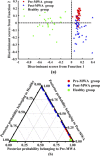Raman spectroscopy combined with multivariate analysis to study the biochemical mechanism of lung cancer microwave ablation
- PMID: 32133237
- PMCID: PMC7041477
- DOI: 10.1364/BOE.383869
Raman spectroscopy combined with multivariate analysis to study the biochemical mechanism of lung cancer microwave ablation
Abstract
Lung cancer is the leading cause of death in cancer patients, and microwave ablation (MWA) has been extensively used in clinical treatment. In this study, we characterized the spectra of MWA-treated and untreated lung squamous cell carcinoma (LSCC) tissues, as well as healthy lung tissue, and conducted a preliminary analysis of spectral variations associated with MWA treatment. The results of characteristic spectral analysis of different types of tissues indicated that MWA treatment induces an increase in the content of nucleic acids, proteins, and lipid components in lung cancer tissues. The discriminant model based on the principal component analysis - linear discriminant analysis (PCA-LDA) algorithm together with leave-one-out cross validation (LOOCV) method yield the sensitivities of 90%, 80%, and 96%, and specificities of 86.2%, 93.8%, and 100% among untreated and MWA-treated cancerous tissue, and healthy lung tissue, respectively. These results indicate that Raman spectroscopy combined with multivariate analysis techniques can be used to explore the biochemical response mechanism of cancerous tissue to MWA therapy.
© 2020 Optical Society of America under the terms of the OSA Open Access Publishing Agreement.
Conflict of interest statement
The authors declare that there are no conflicts of interest related to this article.
Figures





Similar articles
-
Study on the biochemical mechanisms of the micro-wave ablation treatment of lung cancer by ex vivo confocal Raman microspectral imaging.Analyst. 2020 Jan 20;145(2):626-635. doi: 10.1039/c9an01524h. Analyst. 2020. PMID: 31782420
-
Rapid detection of nasopharyngeal cancer using Raman spectroscopy and multivariate statistical analysis.Mol Clin Oncol. 2015 Mar;3(2):375-380. doi: 10.3892/mco.2014.473. Epub 2014 Dec 2. Mol Clin Oncol. 2015. PMID: 25798270 Free PMC article.
-
Developing an Algorithm for Discriminating Oral Cancerous and Normal Tissues Using Raman Spectroscopy.J Pers Med. 2021 Nov 9;11(11):1165. doi: 10.3390/jpm11111165. J Pers Med. 2021. PMID: 34834517 Free PMC article.
-
Thermal Ablation of Lung Tumors: Focus on Microwave Ablation.Rofo. 2017 Sep;189(9):828-843. doi: 10.1055/s-0043-109010. Epub 2017 May 16. Rofo. 2017. PMID: 28511267 Review. English.
-
Microwave ablation: state-of-the-art review.Onco Targets Ther. 2015 Jul 6;8:1627-32. doi: 10.2147/OTT.S81734. eCollection 2015. Onco Targets Ther. 2015. PMID: 26185452 Free PMC article. Review.
Cited by
-
Raman Spectroscopy in Open-World Learning Settings Using the Objectosphere Approach.Anal Chem. 2022 Nov 8;94(44):15297-15306. doi: 10.1021/acs.analchem.2c02666. Epub 2022 Oct 24. Anal Chem. 2022. PMID: 36279588 Free PMC article.
-
Development of a rapid and novel diagnostic technique for cardiac amyloidosis using Raman spectroscopy.Res Sq [Preprint]. 2025 Jun 25:rs.3.rs-6795517. doi: 10.21203/rs.3.rs-6795517/v1. Res Sq. 2025. PMID: 40678255 Free PMC article. Preprint.
-
Enhancing Open-World Bacterial Raman Spectra Identification by Feature Regularization for Improved Resilience against Unknown Classes.Chem Biomed Imaging. 2024 May 6;2(6):442-452. doi: 10.1021/cbmi.4c00007. eCollection 2024 Jun 24. Chem Biomed Imaging. 2024. PMID: 39474520 Free PMC article.
-
Current Trends of Raman Spectroscopy in Clinic Settings: Opportunities and Challenges.Adv Sci (Weinh). 2024 Feb;11(7):e2300668. doi: 10.1002/advs.202300668. Epub 2023 Dec 10. Adv Sci (Weinh). 2024. PMID: 38072672 Free PMC article. Review.
-
Diagnosis of Lung Cancer by FTIR Spectroscopy Combined With Raman Spectroscopy Based on Data Fusion and Wavelet Transform.Front Chem. 2022 Jan 26;10:810837. doi: 10.3389/fchem.2022.810837. eCollection 2022. Front Chem. 2022. PMID: 35155366 Free PMC article.
References
-
- Zhang L., “SC17.02 Lung Cancer in China: Challenges and Perspectives,” J. Thorac. Oncol. 12(1), S113–S114 (2017).10.1016/j.jtho.2016.11.100 - DOI
-
- Kodama H., Ueshima E., Gao S., Monette S., Paluch L.-R., Howk K., Erinjeri J. P., Solomon S. B., Srimathveeravalli G., “High Power Microwave Ablation of Normal Swine Lung: Impact of Duration of Energy Delivery on Adverse Event and Heat Sink Effects,” Int. J. Hyperthermia 34(8), 1186–1193 (2018).10.1080/02656736.2018.1447149 - DOI - PMC - PubMed
LinkOut - more resources
Full Text Sources
